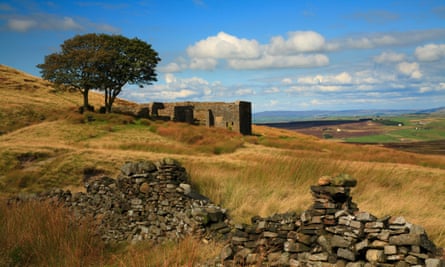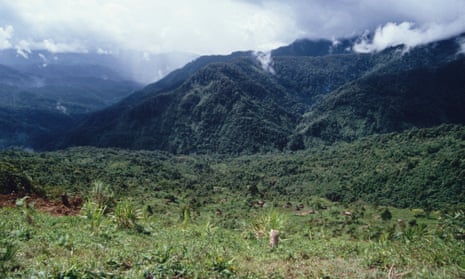We had climbed, slowly, to a high mountain ridge. We were two young Englishmen who were not supposed to be here – journalism was forbidden – and four local guides, members of the Lani tribe. Our guides were moving us around the highlands of West Papua, taking us to meet people who could tell us about their suffering at the hands of the occupying Indonesian army.
The mountain ridge was covered in deep, old rainforest, as was the rest of the area we had walked through. This forest, to the Lani, was home. In the forest they hunted, gathered food, built their homes, lived. It was not a recreation or a resource: there was nothing romantic about it, nothing to debate. It was just life.
Now, as we reached the top of the ridge, a break in the trees opened up and we saw miles of unbroken green mountains rolling away before us to the horizon. It was a breathtaking sight. As I watched, our four guides lined up along the ridge and, facing the mountains, they sang. They sang a song to the forest whose words I didn’t understand, but whose meaning was clear enough. It was a song of thanks; of belonging.
To the Lani, I learned later, the forest lived. This was no metaphor. The place itself, in which their people had lived for millennia, was not an inanimate “environment”, a mere backdrop for human activity. It was part of that activity. It was a great being, and to live as part of it was to be in a constant exchange with it. And so they sang to it; sometimes, it sang back.

When European minds experience this kind of thing, they are never quite sure what to do with it. It’s been so long since we had a sense that we dwelled in a living landscape that we don’t have the words to frame what we see. Too often, we go in one of two directions, either sentimentalising the experience or dismissing it as superstition.
To us, the wild places around us (if there are any left) are “resources” to be utilised. We argue constantly about how best to use them – should we log this forest, or turn it into a national park? – but only the bravest or the most foolish would suggest that this might not be our decision to make. To modern people, the world we walk through is not an animal, a being, a living presence; it is a machine, and our task is to learn how it works, the better to use it for our own ends.
The notion that the non-human world is largely inanimate is often represented as scientific or rational, but it is really more like a modern superstition. “It is just like Man’s vanity and impertinence,” wrote Mark Twain, “to call an animal dumb because it is dumb to his dull perceptions.” We might say the same about a forest; and science, interestingly, might turn out to be on our side.
In recent years, several studies have demonstrated that plants, for example, communicate with each other in ways that seem to point towards some degree of self-awareness. They release pheromones to warn of insect attacks, and other plants respond. They signal to each other using a series of electrical impulses not dissimilar to an animal’s nervous system. They send out airborne distress signals to insect predators that feed on the plant-eaters threatening them.
Underground, meanwhile, are the mycelia: huge fungal networks connecting the roots of thousands of plants and trees. The more mycelia are studied, the more intriguing they appear. Once thought to be a simple means of nutrient exchange, they are now beginning to look like complex systems of inter-plant communication: a “collective fungal consciousness”, according to mycologist Paul Stamets. Ecologist Stephan Harding believes they “possess an eerie intelligence, and probably a peculiar sense of self to boot”.
The supposedly secular west still clings to the Abrahamic notion that only humans possess consciousness – or souls – and that this gives us the right, or the duty, to run the world. The scientists investigating animal and plant consciousness, though, may be taking us back to older ways of seeing by very modern means. The living world around us may turn out to be much more sentient, aware and connected than we have allowed ourselves to believe.
I wonder what our writing would look like if we took this notion seriously; in particular, what our fiction would look like. That the world is a machine is one story; that the world is alive and aware is another. The latter story has probably been taken for granted by the majority of human societies throughout history. The former has only really taken root in ours: post-Enlightenment, industrial western culture. The results of it – climate change, mass extinction, factory farming – should be enough to make us wonder if this story is badly constructed, badly told, or just plain wrong.
The novel is an artifact of western individualism. Novels really came into their own in Europe with the rise of the commercial bourgeoisie; with empire and global trade, with cities and science and reason, with the notion of humans as primary actors in the world’s drama. The same society that gave us the concept of the world as an inanimate backdrop to human activity gave us the novels which catalogued that story.
Most classic novels in the western canon are examinations of the human psyche, or the relationships between small groups of people and their societies. They are studies of the individual human mind. But what about the mind of the world itself? If awareness, consciousness, feelings – life – all extend far beyond the human domain, why do novels continue to behave as if humans were the only actors? Why do we turn over the same exhausted soil again and again? What would a novel look like if it were written by someone who sang to the forest, and believed it sang back?
Robert Graves, in his poetic manifesto The White Goddess, wrote that modern poetry’s function was to lay bare the results of humanity’s break from the rest of nature:
Once a warning to man that he must keep in harmony with the family of living creatures among which he was born … it is now a reminder that he has disregarded the warning, turned the house upside down by capricious experiments in science, philosophy and industry, and brought ruin upon himself and his family.
If this is true of poetry, it is true of fiction too. Perhaps, in a century’s time, any literary critics still clinging to their positions as the seas rise around them will see the work we writers produce today as a useful historical record of our society’s insanity. Because we have cut ourselves off from everything else that lives, and because we don’t believe that it does live, we have ended up talking only to ourselves. We have ended what Thomas Berry called “the great conversation” between humans and other forms of life. We are becoming human narcissists, entombed in our cities, staring into our screens, seeing our faces and our minds reflected back and believing this is all there is. Outside the forests fall, the ice melts, the corals die back and the extinctions roll on; but we keep writing our love letters to ourselves, oblivious.
What might the alternative look like? Perhaps the poets can see this better than the novelists. Robinson Jeffers, poet of the California cliffs, spent his life trying to transcribe the song of the living world and make it fit for human ears. He ends his poem “Carmel Point” with a prescription:
We must uncentre our minds from ourselves;
We must unhumanise our views a little, and become confident
As the rock and ocean that we were made from.
The ecological crisis we have spawned will “unhumanise” our views for us, whether we like it or not. The notions that only humans matter, or that humans are in control, even of themselves, are unlikely to outlast this century. It seems a good time for writers to begin writing about the rock and ocean as if they had a part to play. The novel looks pretty exhausted these days. Could this be its new frontier?
There have always been novels in which the landscape, and the non-human creatures in it, have played a powerful part. Just looking along my bookshelf I can see Thomas Hardy’s Jude the Obscure and The Return of the Native, in which the rural landscapes of his still pre-modern Wessex are as memorable as his human characters; Emily Brontë’s Wuthering Heights, whose wild Pennine uplands experience moods as dark as that of Heathcliff; Ursula Le Guin’s Earthsea trilogy, set in a fictional archipelago whose islands are as distinctive as any on our planet; and DH Lawrence’s The Plumed Serpent, set in a dark pagan Mexico that lingers in the mind longer than its storyline. More recently, and more locally, fiction by young writers such as Ben Myers and Daisy Johnson weave stories around wild English landscapes which act as ominous backdrops to the human stories they tell; stories which seem smaller as a result, and thus more urgent.

A powerful landscape is one thing, though; a sentient landscape is another. A question that has been jabbing at me for some time is: how could a novel be written in which a living landscape was not just a backdrop, but a character: an actor in the drama, rather than its scenery? Are there novels in which non-human places are sensate? In which the mind of the world is made manifest in the places its human characters walk through? Having just tried to write one myself, I have been looking for precedents. So far, I have only discovered two writers who seem to even approach the question.
The first is William Golding, in his 1956 novel Pincher Martin. The eponymous sailor, blown into the sea when his boat is torpedoed during the second world war, washes up on the only land for miles around: a great, jagged, black rock, which juts above the waves. For the next 200 pages there is only Martin, the gulls, the anemones, and the rock, which seems, at first, to be simply an inanimate object. But the rock is something more.
It’s hard to explain why without ruining the novel’s startling conclusion, but it’s safe to say that the rock is also a conduit for a voice, a confessional, a testing ground, a judge. The rock is waiting and watching, and the man on the rock is refusing to be part of it, refusing to believe that there is anything outside his own self. Whether he likes it or not, the rock has a lesson for him, which he is going to have to learn.
Perhaps the writer who has done most to explore the notion of a sensate landscape, though, is Alan Garner. The living, jolting, magical power of places is at the heart of almost everything he has written for the last five decades. A moor, a hill, a ridge, a wood: in Garner’s books these are not landscapes but conduits to an older, wilder magic. History tugs at them, and they tug in turn at the feet of the innocent people who happen to walk across them.
In his 2003 novel, Thursbitch, the Pennine valley which gives the book its title links two people separated by time, one in the 18th century, one living today. Garner’s deep knowledge and understanding of the place and its history is typical of his work, but so too is the sense that this landscape is hungry: it wants something; it is almost toying with people. It is as if the place has brought the book’s human actors together for a reason: as if some riddle must be solved, some destiny fulfilled. Ancient, pagan energies seem to emanate from the old valley, drawing people in across time, weaving the threads, constructing a pattern which humans may always be too small to comprehend.
Are there other novels, and other novelists, which make the world beyond the human, the land itself, a living part of their story? There may be dozens that I haven’t yet come across. If not, maybe the lack reflects a peculiarity of the English-language novel, or of the European novel, or of the rational, liberal, urban minds that tend to write them. Or maybe it is just impossible for any of us, ultimately, to “unhumanise our views”. Maybe we can only ever speak to, and of, ourselves.
But I’m not so sure. Writing a story is an act of projection. We imagine what it would be like to be this character, to live in this time, to be in this situation. Why can’t we make the same imaginative leap and take ourselves out of our humanity? Is it harder to imagine a sensate landscape, or the worldview of another living being, than it is to imagine life on a Martian colony or in a 15th-century village?
Probably. Still, that’s not a reason not to try. Glorious failures are always more interesting than unambitious successes. And surely the times demand it. “The universe is not a machine after all,” proclaimed DH Lawrence, a man who never stopped paying attention to it; “it’s alive and kicking”. Kicking and singing and watching, too. Who will write its story?

Comments (…)
Sign in or create your Guardian account to join the discussion